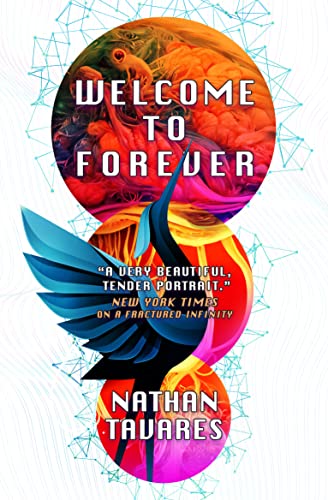
Welcome to Forever
by NATHAN TAVARES
In a near-future world where memories and consciousness can be edited, uploaded, and endlessly replayed, Fox, a memory editor, awakens in a rehabilitation center after a terrorist attack has shattered his recollections and erased his husband Gabe from existence. As Fox navigates looping, unreliable realities and fragmented memories, he confronts the nature of love, identity, and grief, raising profound questions about what makes us who we are and whether true connection can survive in a world where nothing is ever truly lost—or truly real.
Reader Review Summary
Set in a near-future world where memory editing and consciousness transfer have become commonplace, the novel follows Fox, a skilled memory editor who wakes up in a rehabilitation center with no recollection of how he arrived there. He is told he was a victim of a terrorist bombing orchestrated by Khadija Banks, a revolutionary and pioneer of memory technology, which resulted in the loss of his husband Gabe’s memory archive. The narrative unfolds through Fox’s attempts to reconstruct his life and relationship by piecing together fragmented and unreliable memories, often blurring the lines between reality, simulation, and edited recollections. The story is structured non-linearly, with frequent shifts between past and present, and incorporates elements of Egyptian mythology, corporate dystopia, and philosophical questions about identity, memory, and the nature of self, all while centering on the complex, long-term relationship between Fox and Gabe.
Readers praised the book for its intricate exploration of memory, identity, and the consequences of advanced technology on human relationships. Many found the depiction of Fox and Gabe’s relationship to be emotionally resonant, realistic, and deeply rooted in the queer experience, with flawed, well-developed characters whose traumas and coping mechanisms drive the narrative. The world-building, including the mechanics of memory editing and the societal implications of consciousness transfer, was frequently highlighted as immersive and thought-provoking. Several reviewers appreciated the book’s willingness to tackle difficult questions about personhood, grief, and the ethics of technological intervention, as well as its detailed, sometimes stream-of-consciousness writing style and the inclusion of a diverse cast, particularly the character of Khadija Banks.
A significant portion of readers found the book confusing or difficult to follow, citing the non-linear structure, frequent shifts in perspective, and layered realities as barriers to understanding the plot. The narrative’s complexity, with its nested memories, simulations, and unreliable narration, left some readers feeling disoriented or unable to connect emotionally with the characters. The ending, especially the epilogue or coda, was a common point of contention, with some feeling it undermined the story or failed to provide sufficient closure or explanation. Others noted that the world-building, while ambitious, sometimes lacked clarity, and that side characters could feel underdeveloped compared to the central relationship.
The book has drawn comparisons to works like 'Tomorrow, and Tomorrow, and Tomorrow,' 'Eternal Sunshine of the Spotless Mind,' and 'Evangelion,' and is positioned within the genres of science fiction, queer fiction, and romance. It has received a moderate average rating from readers, with a mix of highly positive and critical reviews, and is noted for its ambitious scope and willingness to challenge readers with its structure and themes. Some readers found the book’s meditation on memory and identity intellectually stimulating, while others struggled with its demands on attention and comprehension. The novel’s approach to queer representation and its integration of speculative technology into personal and societal dilemmas were frequently mentioned as distinguishing features.
Copyright ©2024 Hidden Sci-Fi






